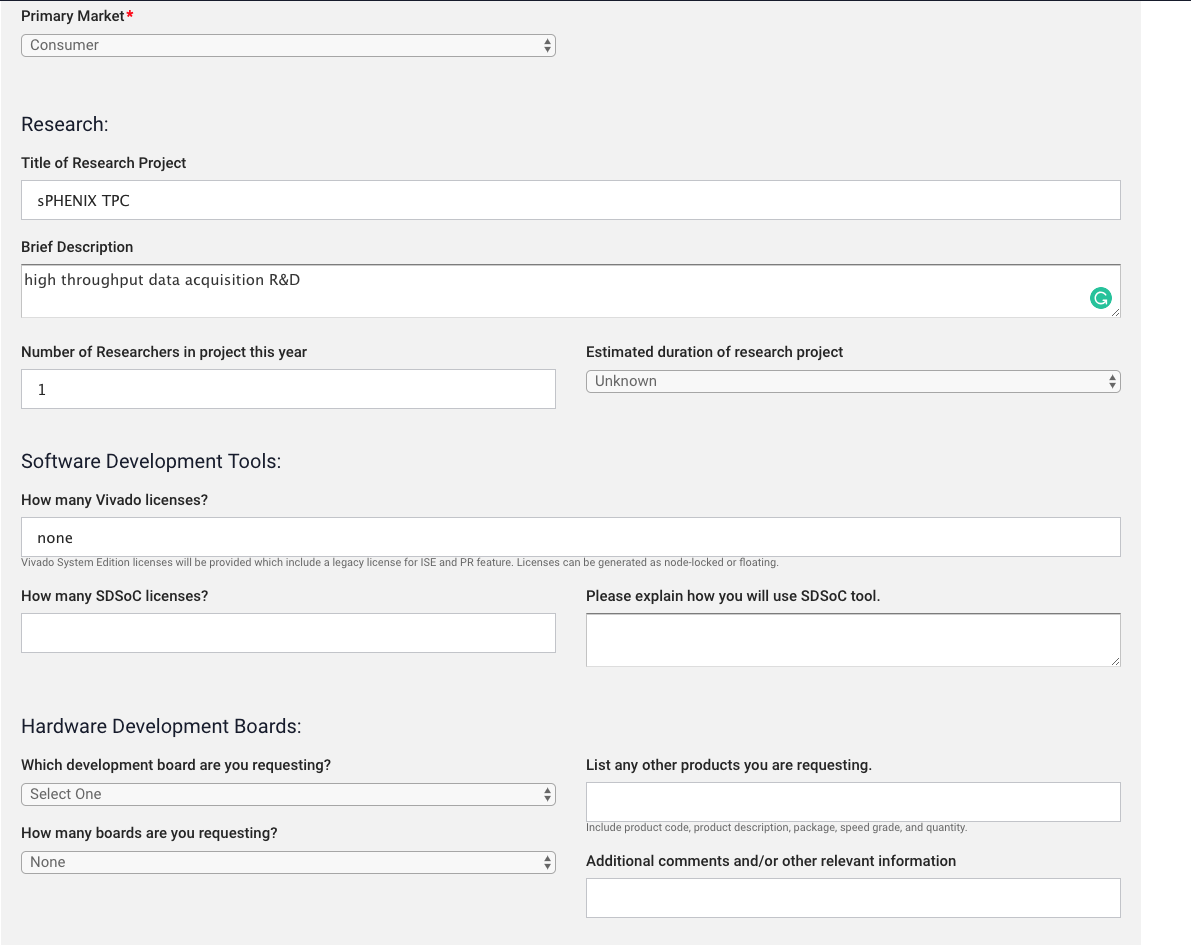sphenix-tpc-l AT lists.bnl.gov
Subject: Sphenix-tpc-l mailing list
List archive
Re: [Sphenix-tpc-l] Bi-weekly sPHENIX TPC General Meeting on Wednesday, March 13, 3 PM - 4 PM EDT
- From: Thomas K Hemmick <Thomas.Hemmick AT stonybrook.edu>
- To: Sasha Milov <alexander.milov AT weizmann.ac.il>
- Cc: "sphenix_tpc_general AT skipper.physics.sunysb.edu" <sphenix_tpc_general AT skipper.physics.sunysb.edu>, matt posik <mposik1983 AT gmail.com>
- Subject: Re: [Sphenix-tpc-l] Bi-weekly sPHENIX TPC General Meeting on Wednesday, March 13, 3 PM - 4 PM EDT
- Date: Wed, 24 Apr 2019 10:00:28 -0400
============
hi allcan you advice what to fill into the xilinx request fields?thanksa.m.On Wed, Mar 13, 2019 at 11:06 PM matt posik <mposik1983 AT gmail.com> wrote:Thanks!
I just submitted the donation request. I will keep you posted.
Thanks,Matt
On Wed, Mar 13, 2019, 4:09 PM Huang, Jin <jhuang AT bnl.gov> wrote:
Dear Matt
Sure. Will be happy to. Please find the suggestion below.
Cheers
Jin
______________________________
Following Tom's suggestion in the TPC general meeting today, I am writing to follow up with the details of the Xilinx University Donation program. The idea to apply to this program originates from a comment received during the CD-1 review. Tom worked through this process and received five FELIX FPGAs which represents a significant cost-saving in the TPC DAM R&D and production. We will appreciate further helps from other university collaborators too.
It does take some effort to apply to the Xilinx University Donation program. At the first step, the donation can be requested at https://www.xilinx.com/support/university/donation-program.html
* Our research project (high throughput data acquisition R&D or some fancier names)
* Software Development Tools: (not required)
* In the Hardware Development Boards section
** Hardware Development Boards: Other
** List any other products you are requesting: Kintex-7 Ultrascale FPGA with the part number of XCKU115-2FLVF1924E.
** How many boards are you requesting: (about five seems possible)
After passing the first round of evaluation, Xilinx will contact the PI regarding information on the project for their further assessment.
Please feel free to let Tom and I know if there is any question or suggestions.
______________________________
Jin HUANG
Associate Physicist
Brookhaven National Laboratory
Physics Department, Bldg 510 C
Upton, NY 11973-5000
Office: 631-344-5898
Cell: 757-604-9946
______________________________
From: Sphenix-tpc-l <sphenix-tpc-l-bounces AT lists.bnl.gov> On Behalf Of matt posik
Sent: Wednesday, March 13, 2019 4:04 PM
To: Klaus Dehmelt <klaus.dehmelt AT stonybrook.edu>
Cc: sphenix_tpc_general AT skipper.physics.sunysb.edu
Subject: Re: [Sphenix-tpc-l] Bi-weekly sPHENIX TPC General Meeting on Wednesday, March 13, 3 PM - 4 PM EDT
Hi All,
I took a look through my emails and can not find the one that was sent regarding the chips that were mentioned during today's meeting.
Is there any chance that we can recirculate that email?
Thanks,
Matt
On Tue, Mar 12, 2019 at 9:06 PM Klaus Dehmelt <klaus.dehmelt AT stonybrook.edu> wrote:
Dear all,
we will continue with our bi-weekly meeting tomorrow at 3 PM EDT. You can find a tentative agenda at https://indico.bnl.gov/event/5590/
Please let me know if you have anything to present.
Please note that in the US we are on DST now.
BlueJeans coordinates are
To join the Meeting:
https://bluejeans.com/881710315
To join via Browser:
https://bluejeans.com/881710315/browser
To join with Lync:
https://bluejeans.com/881710315/lync
To join via Cisco Jabber Video:
https://bluejeans.com/881710315/jabber
To join via Room System:
Video Conferencing System: bjn.vc<http://bjn.vc/> -or- 199.48.152.152
Meeting ID: 881710315
To join via Phone:
1) Dial:
+1.408.740.7256<tel:%2B1.408.740.7256>
+1.888.240.2560<tel:%2B1.888.240.2560>(US Toll Free)
+1.408.317.9253<tel:%2B1.408.317.9253>(Alternate number)
(see all numbers - http://bluejeans.com/numbers)
2) Enter Conference ID: 881710315
Cheers,
Klaus
********************************************
Klaus Dehmelt
Stony Brook University
Dept. of Physics and Astronomy
Stony Brook, NY 11794-3800, USA
Office C108
Phone +1 631 632 8115
*********************************************
--
Matthew Posik
Assistant Research Professor
Temple University
Department of Physics
SERC
1925 N. 12th St.
Philadelphia, PA 19122
USA
TU Office: SERC Room 451
Phone: 215-204-8690
Physics Office: SERC Room 406/4th Floor
Phone: 215-204-7421
--Department of Particle Physics and Astrophysics
Weizmann Institute of Science
234 Herzl str. Rehovot 76100, Israel
tel/fax: +972 8 934 2848
-
Re: [Sphenix-tpc-l] Bi-weekly sPHENIX TPC General Meeting on Wednesday, March 13, 3 PM - 4 PM EDT,
Sasha Milov, 04/24/2019
- Re: [Sphenix-tpc-l] Bi-weekly sPHENIX TPC General Meeting on Wednesday, March 13, 3 PM - 4 PM EDT, Thomas K Hemmick, 04/24/2019
-
Message not available
-
Re: [Sphenix-tpc-l] Bi-weekly sPHENIX TPC General Meeting on Wednesday, March 13, 3 PM - 4 PM EDT,
Sasha Milov, 04/25/2019
- Re: [Sphenix-tpc-l] Bi-weekly sPHENIX TPC General Meeting on Wednesday, March 13, 3 PM - 4 PM EDT, Tarafdar, Sourav, 04/25/2019
-
Re: [Sphenix-tpc-l] Bi-weekly sPHENIX TPC General Meeting on Wednesday, March 13, 3 PM - 4 PM EDT,
Sasha Milov, 04/25/2019
Archive powered by MHonArc 2.6.24.
